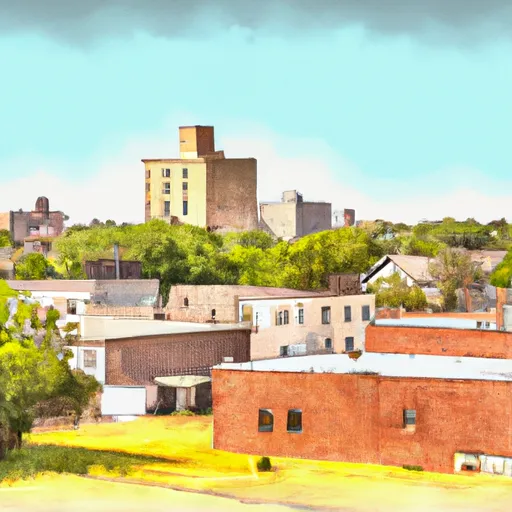-
 Snoflo Premium
Snoflo Premium
Get unlimited access to all our content
With no Ad interruptions! - Start Your Free Trial Login with existing account
Richmond
Eden Index
Climate
9.7
•
Recreation
1.7
•
Community
•
Safeguard
4.5/10

Richmond, Kansas is a small town located in Franklin County. It experiences a continental climate with four distinct seasons. Summers are hot and humid, with temperatures reaching the high 80s to low 90s°F (30-35°C). Winters are cold, with temperatures dropping to the low 20s°F (-5°C). Spring and fall offer pleasant weather, with temperatures ranging between the 50s and 70s°F (10-25°C).
The town is situated along the Marais des Cygnes River, which provides a vital hydrological feature to the area. The river serves as a tributary to the Kansas River and offers opportunities for fishing, canoeing, and kayaking. Additionally, the nearby Pomona Lake is a popular spot for boating, swimming, and camping.
Richmond boasts several outdoor recreation opportunities, including the Richmond City Lake, which offers a variety of activities such as fishing and picnicking. The Flint Hills Nature Trail, a 117-mile pathway for hiking, biking, and horseback riding, passes near Richmond and provides scenic views of the surrounding prairie landscape. The town also has several parks and green spaces for leisurely walks and family gatherings.
In conclusion, Richmond, Kansas, with its continental climate and proximity to the Marais des Cygnes River and Pomona Lake, offers a range of outdoor recreation opportunities for residents and visitors alike.
What is the Eden Index?
The Snoflo Eden Index serves as a comprehensive rating system for regions, evaluating their desirability through a holistic assessment of climate health, outdoor recreation opportunities, and natural disaster risk, acknowledging the profound impact of these factors on livability and well-being.
Climate Health Indicator (CHI): 9.7
Richmond receives approximately
996mm of rain per year,
with humidity levels near 79%
and air temperatures averaging around
13°C.
Richmond has a plant hardyness factor of
6, meaning
plants and agriculture in this region thrive during a short period during spring and early summer. Most
plants will die off during the colder winter months.
By considering the ideal temperature range, reliable water supplies, clean air, and stable seasonal rain or snowpacks, the Climate Health Indicator (CHI) underscores the significance of a healthy climate as the foundation for quality living.
A healthy climate is paramount for ensuring a high quality of life and livability in a region, fostering both physical well-being and environmental harmony. This can be characterized by ideal temperatures, reliable access to water supplies, clean air, and consistent seasonal rain or snowpacks.
Weather Forecast
Streamflow Conditions
Osage
Area Rivers
Osage
Snowpack Depths
Osage
Reservoir Storage Capacity
Osage
Groundwater Levels
Recreational Opportunity Index (ROI): 1.7
The Recreational Opportunity Index (ROI) recognizes the value of outdoor recreational options, such as parks, hiking trails, camping sites, and fishing spots, while acknowledging that climate plays a pivotal role in ensuring the comfort and consistency of these experiences.
Access to outdoor recreational opportunities, encompassing activities such as parks, hiking, camping, and fishing, is crucial for overall well-being, and the climate plays a pivotal role in enabling and enhancing these experiences, ensuring that individuals can engage in nature-based activities comfortably and consistently.
Camping Areas
| Campground | Campsites | Reservations | Toilets | Showers | Elevation |
|---|---|---|---|---|---|
| Elmore Park | None | 805 ft | |||
| Blue Bill Point - Fort Gibson Lake | None | 568 ft | |||
| Spavinaw State Park | 100 | 638 ft | |||
| South Lake Veterans Memorial Park - Garnett | 5 | 1,026 ft | |||
| Lake Garnett City Park | None | 1,035 ft | |||
| Rocky Point - Fort Gibson Lake | None | 572 ft | |||
| East River Park | None | 790 ft | |||
| Chouteau Bend - Fort Gibson Lake | None | 610 ft | |||
| Snowdale State Park | None | 633 ft | |||
| Flat Rock Creek - Fort Gibson Lake | None | 588 ft |
Nearby Fishing
Catastrophe Safeguard Index (CSI):
The Catastrophe Safeguard Index (CSI) recognizes that natural disaster risk, encompassing floods, fires, hurricanes, and tornadoes, can drastically affect safety and the overall appeal of an area.
The level of natural disaster risk in a region significantly affects safety and the overall livability, with climate change amplifying these risks by potentially increasing the frequency and intensity of events like floods, fires, hurricanes, and tornadoes, thereby posing substantial challenges to community resilience and well-being.
Community Resilience Indicator (CRI):
The Community Resilience Indicator (CRI) recognizes that education, healthcare, and socioeconomics are crucial to the well-being of a region. The CRI acknowledges the profound impact of these elements on residents' overall quality of life. By evaluating educational resources, healthcare accessibility, and economic inclusivity, the index captures the essential aspects that contribute to a thriving community, fostering resident satisfaction, equity, and social cohesion.

